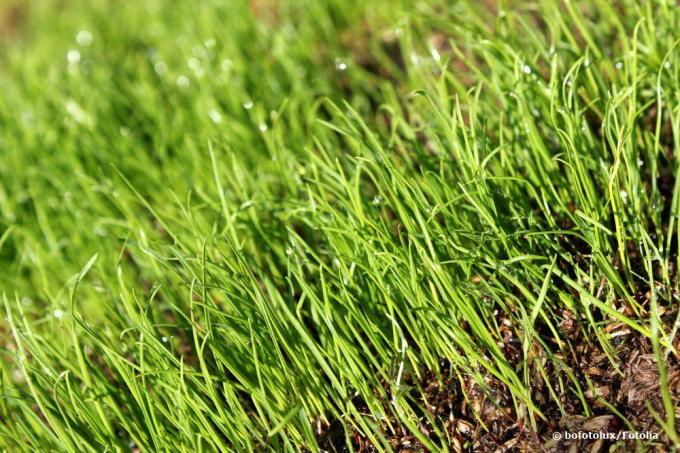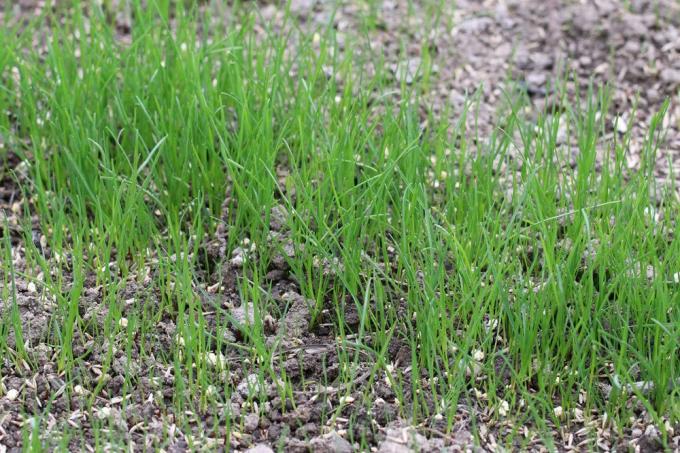
table of contents
- The right time to mow the lawn
- Influencing factors
- Height of grass
- Weather and soil conditions
- Mowing the lawn according to the 'one-third rule'
A well-groomed, lush green one race is the figurehead of a garden. The whole thing is promoted, among other things, by regular lawn mowing, provided the seeds used are of good quality. A regular cut also has the advantage that competition from weeds is contained. So that freshly sown lawn can meet these requirements, the focus is on mowing the lawn. There are a few things to consider when it comes to the right time and the cutting height.
The right time to mow the lawn
To create the best conditions for a dense lawn, you should sow in late summer. The temperatures are no longer that high and the ground is still warm. You should allow some time to pass before you mow a freshly sown lawn for the first time. The height of the grass as well as the prevailing weather conditions and the nature of the soil serve as a meaningful guide to when the best time is.
Influencing factors
Height of grass
When to mow for the first time depends on a number of factors. The first time you should never cut freshly sown lawn too early. The young plants must be strong enough and well anchored in the ground. Otherwise it can happen that they are not cut off when mowing the lawn, but rather torn from the ground together with their roots. But when should you mow for the first time?
- Do not mow too early or wait too long
- Do not exceed the maximum height of the grass
- Otherwise the vegetation point will shift upwards
- It would be injured during the cut or even removed with it
- Grasses then need much longer to sprout again
- That would result in patchy growth
- We recommend growing heights of at least 7-10 cm
- Once this height has been reached, it can be cut down to 5-6 cm
- Desired height adjustable on most mowers
- Minimum heights before the first cut can vary depending on the type of lawn
- Normal sports and play lawn 7-7.5 cm
- Ornamental lawn 8-8.5 cm
- Shadow lawn 10 cm
- Shadow lawns should generally stay a little longer
tip: The optimal height before the first cut can only be estimated through mere eye contact. However, since this first cut lays the foundation for an even and gapless sward, you should not be afraid to use a folding rule in case of doubt.
Weather and soil conditions
Even if the height of the freshly sown grass plays a key role in choosing the perfect time, it is not the only criterion. The prevailing weather and the nature of the soil are no less important. If you have sown after winter, growth will progress well on warm days in spring. If the sowing was done in autumn, the stalks need a lot more time to gain height.
- When mowing a freshly sown lawn for the first time in spring, consider late frosts in the ground
- The first frost in autumn should also be a long way off at the time of mowing
- If the optimum height is not reached before the onset of winter, stop mowing the lawn
- Then move the first cut to spring
- Grasses stop growing in winter anyway
- Always choose dry and cloudy weather for the first mowing process
- Wait for days without intense sun exposure
- The lawn should be dry
If it is wet, the mower would not be able to cut it cleanly, the clippings would clump together and clog the mower. In addition, the more severe sinking of the mower due to its weight or simply slipping on the wet surface can damage the sward. In addition to a largely dry lawn, the minimum temperature at night should not fall below five degrees.
tip: An unmowed lawn should not be stepped on before the lawn is cut. The trampled stalks only straighten up very slowly, so that the mower cannot grasp them and ultimately the result is an uneven cutting pattern.
Mowing the lawn according to the 'one-third rule'
The first cut that comes as a Cupping cut is called, promotes the formation of clumps and runners and thus contributes to the formation of a dense, closed sward. It should not be too low and should be based on the 'one-thirds rule'. This means that per mowing pass, a maximum of one third of the current growth height must be shortened.
When the lawn has reached a height of 8 cm, set a cutting height of 5 cm on the mower. Again, the cutting height varies depending on the type of lawn. In shady areas you should never cut shorter than 4-5 cm.
Otherwise, when making the first cut, be careful not to mow with heavy equipment, as this would leave traces in the fresh green. The blades of the mower should be sharp so that the grass is cut cleanly and not torn off. Frayed interfaces serve as entry points for a wide variety of pathogens. The clippings are carefully removed after mowing, unless you are using a mulching mower. The gentlest way to do this is with a rake that has rubber tines. If you pay attention to these things, nothing stands in the way of a lush green and dense lawn.





